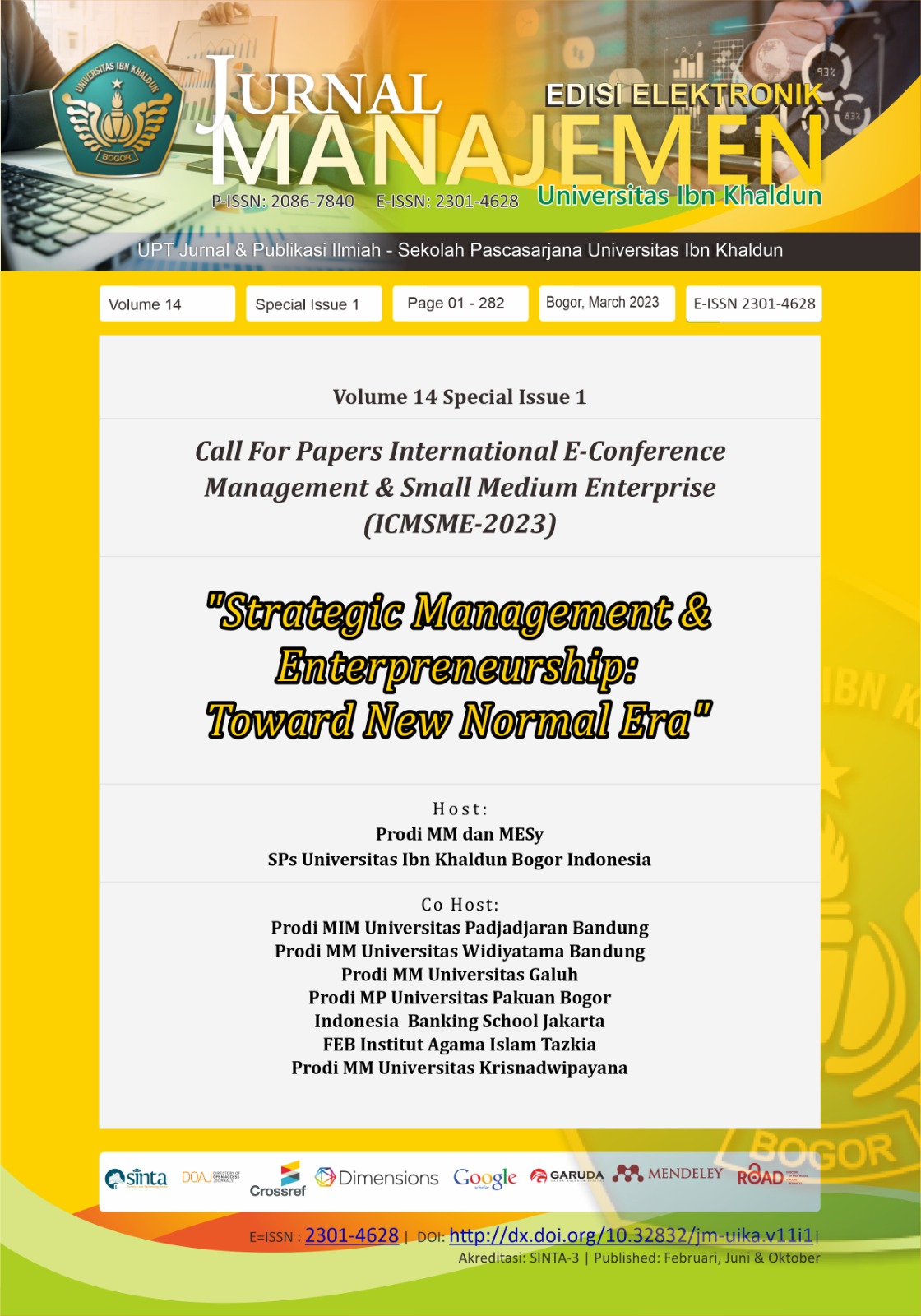Self-Service Optimization: Comprehending Customer Satisfaction
DOI:
https://doi.org/10.32832/jm-uika.v14i1.9791Keywords:
self-service, marketing communication strategy, consumer satisfaction, laundry.Abstract
Today, washing clothes is a separate problem for some people. This is because not a few people have very busy activities in their daily lives. Indirectly, they decided to use a laundry service which was considered fast and efficient due to the limited time they had. Self-service laundry service is a laundry service that has a customer service system that will wash their own clothes at the laundry in a short time. Self-service based methods have developed very rapidly in various business sectors. This study purpose is to determine the level of customer satisfaction and their level of loyalty to self-service-based laundry services. This study uses the SEM-PLS analysis method. Data is obtained through observation with business owners/supervisors in order to understand the patterns and mechanisms of implemented marketing communications. As well as distributing an online questionnaire based on The Flower of Service which was filled in by 302 respondents to understand the level of customer satisfaction. This study reveals that self-service-based laundry services are supported by optimizing business strategies, especially in digital-based integrated service marketing communications that have been carried out. The results of the study revealed that customers stated quite high levels of satisfaction and loyalty. This research contributes to the service marketing literature by revealing the perspectives of customer satisfaction and loyalty in self-service-based service businesses. There have been many studies conducted to discuss this laundry service business. However, there are no research findings regarding Self-service Optimization.
References
Abdillah, W., & Hartono, J. (2015).Partial least square (PLS): Alternative structural equation modeling (SEM) in business research. Yogyakarta: ANDI.
Alonso-Garcia, J., Pablo-Martí, F., & Nunez-Barriopedro, E. (2021). Omnichannel Management in B2B. Complexity-based model. Empirical evidence from a panel of experts based on Fuzzy Cognitive Maps. Industrial Marketing Management, 95(April), 99-113. https://doi.org/10.1016/j.indmarman.2021.03.009
Amrozi, Y., Rijal, S., Rif'an, M. K., Rizki, A. M., Dwiki, F., & Dara, A. R. (2018). Integrated Marketing Communications.Marketing. http://repository.uinsby.ac.id/id/eprint/880
Ardiansyah, F. W. (2019).Revealing Natasha Laundry's Success Strategy in Maintaining Its Business. Semarang University.
Bahri, R., & Hj. Naharia. (2019). Laundry Service Business Development in Increasing Household Marginal Income in Islamic Economic Perspective in Watampone (Study on Octa Laundry).Al Tsarwah Scientific Journal, 1(2), 180-201. 10.30863/al-tsarwah.v1i2.263
Castro, D., Atkinson, R., & Ezell, S. J. (2010). Embracing the Self-Service Economy. SSRN Electronic Journal, 10(2), 21-39. http://dx.doi.org/10.2139/ssrn.1590982
CUCI Express Laundry. (2020, January 6). Wash Indraprasta express laundry. Google Maps. Retrieved January 11, 2023, from https://goo.gl/maps/nwJUW3cBt1sy4pfaA
Firdiansyah, A. (2021, October 10). Customer Journey: Miscellaneous Important Roles in the Company. Glints. Retrieved January 9, 2023, from https://glints.com/id/lowongan/customer-journey-dalam-pengembangan-bisnis/#.Y74V4KBBztQ
Gao, M., & Huang, L. (2021). Quality of channel integration and customer loyalty in omnichannel retailing: The mediating role of customer engagement and relationship program receptiveness. Journal of Retailing and Consumer Services, 63(November). https://doi.org/10.1016/j.jretconser.2021.102688
Lovelock, C., & Wirtz, J. (2011). Service Marketing Perspective (7th ed.). Jakarta: Erlangga.
Pope Constantinidis, S. (2017). The SoLoMo customer journey: a review and research agenda.Journals Innovative Marketing, 13(4), 47-54. http://dx.doi.org/10.21511/im.13(4).2017.05
Priyono, B. P. C., & Rahmadanik, D. (2021). Increasing Umkm Turnover Laundry Services In The New Normal Era With Self Laundry Service Innovations In Dharmawangsa Village.Serving Patriot National Seminar, 1(1). https://conference.untag-sby.ac.id/
Radhitama, J. I. (2016). Analysis of the Influence of Social Media Marketing on Brand Loyalty with Brand Equity as a Mediating Variable on the @gojekindonesia Instagram Account (Study on GO-JEK Consumers in Malang City).Student Scientific Journal of the Faculty of Economics and Business, 6(2).
RevU. (2019).What is Customer Journey? Definition and examples. Revou.co. Retrieved January 11, 2023, from https://revou.co/kosakata/customer-journey
Santia, T. (2022, August 8).9.5 Million MSMEs Have Entered the Digital Ecosystem until June 2022. Liputan6.com. Retrieved December 18, 2022, from https://www.liputan6.com/bisnis/read/5036387/95-juta-umkm-sudah-masuk-ekosistem-digital-hingga-juni-2022
Sarstedt, M., Hair, J., Hult, G. T. M., & Ringle, C. M. (2016). A Primer on Partial Least Squares Structural Equation Modeling (PLS-SEM). SAGE Publications.
Sarstedt, M., Hair, J., Hult, G. T. M., & Ringle, C. M. (2017). A Primer on Partial Least Squares Structural Equation Modeling (PLS-SEM) (2nd ed.). SAGE Publications.
Sugiyono. (2019).Quantitative Research Methods, Qualitative and R&D. Bandung: PT Alfabeta.
Tjiptono. (2019).Marketing Strategy Principles & Applications (1st ed.). Yogyakarta: ANDI.
Wiener, M., HoíŸbach, N., & Saunders, C. (2018). Omnichannel businesses in the publishing and retailing industries: Synergies and tensions between coexisting online and offline business models. Decision Support Systems, 109(May). https://doi.org/10.1016/j.dss.2018.01.008
Wijayanti, N. S. (2018). Role of E-Servqual in Customer Engagement.Journal of Efficiency – Administrative Science Studies, 15(1).
Downloads
Published
How to Cite
Issue
Section
License
Authors who publish with this journal agree to the following terms:
- Authors retain copyright and grant the journal right of first publication with the work simultaneously licensed under a Creative Commons Attribution-NonCommercial-ShareAlike 4.0 International License that allows others to share the work with an acknowledgement of the work's authorship and initial publication in this journal.
- Authors can enter into separate, additional contractual arrangements for the non-exclusive distribution of the journal's published version of the work (e.g., post it to an institutional repository or publish it in a book), with an acknowledgement of its initial publication in this journal.
- Authors are permitted and encouraged to post their work online (e.g., in institutional repositories or on their website) prior to and during the submission process, as it can lead to productive exchanges, as well as earlier and greater citation of published work (See The Effect of Open Access).











